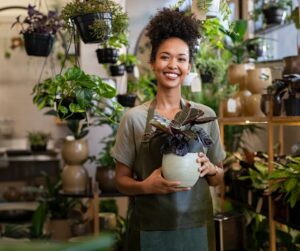Once upon a time in Black Entrepreneur History lived an African American woman named Augusta Fells Savage who became one of the greatest American sculptresses who also founded her own art studio business display and teach wonderful Black art.
Augusta Savage was born Augusta Fells Augusta Christine Fells on February 39, 1892 in Green Cove Springs, Florida to parents Edward Fells and Cornelia Murphy (Fells) in a Christian household being that her father was a minister. She was one of 14 children, and she always had a natural, God given talent for sculpting. While outside as a little girl, she would sculpt from the dirt, or clay, of the ground.
Her father didn’t like it at all, attempting to get her to stop creating images of various animals and items, because he assumed the Bible was against images. However, it was his own misinterpretation of the scriptures when the Bible stated to “make no graven images” which actually meant make no images of anything to worship. Her father took that as any image.
Savage would get in trouble for her craft often, however, she never stopped. Savage would even skip school to sculpt in the dirt, despite getting a spanking whenever her father found out[1].
1907 – Augusta Fells, at the age of 15, married John T. Moore and they had a child Irene Connie Moore, however she was left widowed when he passed away a few years into the marriage. This caused her to have to move back into her parents’ home. From there, they all moved away from Green Cove Springs, Florida to West Palm Beach, Florida as her father assumed a new position in a church.
Due to the fact that she was living under her father’s roof, this slowed her sculpting for a while, but her craft soon picked up speed, especially when her father was placated when she made him a sculpture of the Virgin Mary.
Soon, she began selling her sculptures throughout the town and she caught the attention of many, including the former mayor and principal of an all Black school called Industrial High School, George Graham Currie. Currie was also superintendent and founder of the Palm Beach county fair where he fought for her to gain attention at the fair in her own tent because he was purely amazed at her talent. Currie, as a poet laureate with 18 books of poetry, even wrote a poem about her and her amazing sculptures.
Things weren’t easy at all during this time for Augusta Fells because she was a Black woman. Racial tensions were high in the early 1900s no matter where you lived in America, however, those racial tensions were more noted in the south. She lived in Florida.
Other than animal sculptures, she made busts of people, and many of these busts were of prominent people. If the sculpture was of someone white, it was done from a picture because none would sit for her. An example of this would be her sculpture of Henry Flager, who was a local citizen of prominence. Therefore, most of her sculptures, when of people, were of African Americans in all their majesty, beauty, strength and emotion.

Education & 2nd Marriage
Augusta Fells didn’t care much for school at all. She was more a creative than an a static learner, and that showed from the time she was a little girl. However, she ended up going to what is now known as Florida A&M University, then known as Florida State Normal School in 1920. It was the same Currie that fought for her spot in the Palm Beach county Fair that wrote her a letter of recommendation into New York’s Cooper Union school.
At this time she was also married, having gone into her second marriage in 1915 to James Savage, thus her name change to Savage. The marriage ended in divorce at the same time she was completely out of money. However, the she was given a scholarship from Cooper Union in order to finish. She also took a job as an apartment caretaker in order to pay the rest of her bills.
It was in 1923 that she married again to Robert L. Poston, a lawyer, and he passed away in 1924 of pneumonia. She never remarried. It was in the same year of his passing that she was accepted to a summer arts program which was very prestigious in France, however, after they found out she was a Black woman, the American Government declined her the funds. She ended up studying in Paris anyway from 1929 to 1931. She kept on pushing forward and she was offered an opportunity in Rome, however, had to turn it down because she needed to be there for her aging parents.
She continued working on very prominent African American figures such as WEB DuBois and Marcus Garvey. In 1929, she sculpted Gamin, a sculpture of her nephew named Ellis Ford. This became one of her most prized works of art.
Augusta Savage’s Businesses
Nothing would ever top her natural talent, and Augusta Savage knew this. There was no job or profession that would make her more fulfilled than sculpting or working in the arts. Therefore, in 1932, she founded the Savage Studio of Arts and Crafts in Harlem, NY where she taught and was the 1st African American member of the National Association of Women Painters and Sculptors. She was also the first director of Harlem Community Art Center.
The art center closed in WWII, and when she relaunched another art center in 1939 – Salon of Contemporary Negro Art on 125th Street – it failed soon after due to lack of funds. However, while it was open, it was the home of some of these wonderful pieces of art and more:
- The Jitterbug (tall thin mud figure)
- Lift Up Thy Voices and Sing or Lift Every Voice and Sing also called The Harp (1939)- Negro choral group; commissioned to create and sculpt a representation of the many contributions African Americans made in music; sculpture stood 16 feet tall with 12 Black elongated singers as the strings of the harp while the arm and hand of God held them as the sounding board and a man knelt as the foot pedal. It took Savage two years to complete this project; named after the poem written by James Weldon Johnson; included in the US Pavilion at the NY World Fair; only African American represented at the fair
- After the Glory (large group of 3 figures designed for a war memorial – “a negro mother with hopeless anger” engulfing her face while her daughter wept, clutching her mother’s hand in a tin helmet along with a grandchild “stretching up to play with the identification tags”).
- Girl with Pigtails (1935)
- Portrait of a Baby (1942)
Savage also had nameless pieces, one such piece that sat in the corner of the studio of a child facing outward, sharing the same grief the adults had. About this particular piece, Augusta Savage explained: “I changed it because this shows the innocence of the child.”[2]
Speaking of children, she loved to teach young artists and provide the opportunity for common workers to earn from their own art which had showcase space in her Savage studio. She was also head of the federally funded art program launched by President Franklin Roosevelt.
Savage’s Death
Feeling down and low due to the closure of her art centers, she moved to Saugerites, NY in 1945, but in 1962 moved back to NY to live with her daughter before dying of cancer in 1962. Augusta Fells Savage passed away at Abraham Jacobi Hospital in the Bronx at the age of 70[3].
She is remembered as one of the first Black female sculptresses of American history. She was known as “one of the six Black Masters of Modern Art” by Romare Bearden[4].
Sources
- [1]The Palm Beach Post (West Palm Beach, Florida) 13 Mar 2005, Sun Page 157
- [2]Times Colonist (Victoria, British Columbia, Canada)22 Aug 1939, Tue Page 4
- [3]The Pittsburgh Courier (Pittsburgh, Pennsylvania)07 Apr 1962, Sat Page 20
- [4]The Charlotte Observer (Charlotte, North Carolina) 26 Jan 1994, Wed Page 142
- Picture Public Domain – https://en.wikipedia.org/wiki/Augusta_Savage#/media/File:Augusta_Savage,_H-HNE-20-87.jpg





More Related Stories
James Wormley – Founder of the Most Expensive Hotel in Washington D.C. in 1800s – the Wormley Hotel
William E. Matthews – Wealthy Financial Broker & Civil Rights Leader of 1800s
Charles Porter Grove – Owner of Montana and Illinois Gold Mining Company & Leader of the “Dreamed” Grove City, Montana